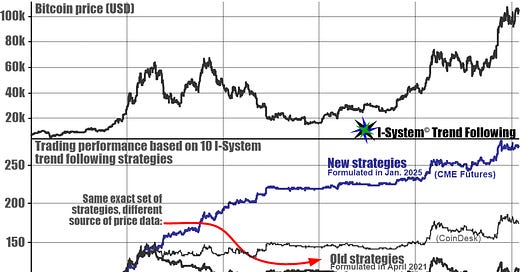Last week I added Bitcoin to this report, based on newly formulated trading strategies. I had added Bitcoin to other TrendCompass reports in May 2021, using strategies which I formulated in early 2021, due to popular demand, even though there were two major issues with this.
First, Bitcoin has a relatively short price history, and as I wrote in the TrendCompass back on 17 April 2021, that history "consists of a series of hockey-stick rallies and long periods of sideways consolidation in between. This makes it difficult to pan out 'high conviction' strategies and I'll certainly need to rework the market in another few years..." The reason why this creates a problem is because, in formulating trend-following strategies, repeated vertical price allies tend to act as 'gravity' points where a very large number of strategies will appear successful, making it difficult to discern the wheat from the chaff. Virtually any strategy that picks up these vertical climbs will appear successful.
To formulate high conviction strategies, we should preferably have 20 or 30 years of price data featuring both favorable and unfavorable market environments. Good strategies must generate significant profits from price trends, but also behave reasonably well during adverse intervals (i.e. not lose too much during corrections, reversals, and price consolidation periods).
A moderately effective strategy is better than no strategy at all
Bitcoin simply didn't have a sufficiently diverse price history in 2021. All the same, having a strategy is better than having no strategy at all. Again from the 17 April 2021 TrendCompass: "for the time being I still believe that using a set of systematic strategies will prove more reliable than discretionary speculation as it will at least prove effective at capturing the gains from large price moves - be it up or down." And indeed, judging by the hundreds of thousands of liquidations of Bitcoin trading accounts that occur during volatile trading periods in Bitcoin, that idea proved to be correct.
The second major issue was related to Bitcoin price data. When I added Bitcoin to this report, I used CoinDesk price data, but this proved unworkable because of the substantial time series corrections which were published almost daily. These often triggered trading signals retroactively, showing changes in our exposure to Bitcoin due to signals that occurred in the past. Once we switched the data feed to CME Futures prices, this issue was resolved.
From about 2021 onwards, Bitcoin has started to mature as a market and its price fluctuations now resemble "normal" assets so, in December last year I started working on a new set of trading strategies, ten of which I finally added to this report last week, replacing the ten old ones. It's no mystery, the new ones appear to be much better: the comparison is below:
Of course, the new strategies appear much better than the old ones. This is no surprise because their performance through mid-January 2025 represents a backest simulation or, in-sample performance. Meanwhile, the "old" ones, from mid-2021 show out of sample performance. Here we come up against the issue of overfitting: bending strategy parameters around the price curve, in order to obtain best performance.
But this is part of life: we've no choice but to train up our strategies using the known data, even though we'll have to use them against unknown price fluctuations. This process simply demands a careful, methodical approach to formulating these strategies and good judgment about which speculative behaviors seem realistic and could be sustained in the future, and which ones seem too good to be true.
The surprising part was in the way our old 2021 strategies performed with CoinDesk's time series. They were originally trained up on that dataset, and as it turns out, they would have performed significantly better, as shown by the skinny grey line in the above chart. That curve also reflects out of sample performance. This conveys one of the early lessons I encountered with formulating systematic trend following strategies: they can be very sensitive to the inputs.
The difference between CME futures data and the CoinDesk data may be imperceptible to a human observer, but a machine, they’re clear as day. The machine learning process I-System runs does affect the outcome: the strategies trained up on CoinDesk data performed much better on that data than they did on nearly identical CME data. For me, the surprise was just how substantial the difference turned out to be after barely 4 years “out of sample.”
Hopefully, this all demystifies systematic trend following strategies a bit, the way they're formulated, and some of the issues involved in the process. The new Bitcoin strategies were trained up on CME Futures price data and, thanks to the last 4 years of more "normal" price fluctuations, should be significantly more reliable and profitable to use than the old set. Regarding the old strategies' relatively poor performance, I still maintain that a moderately effective strategy is still far better than no strategy at all. Recall, a large figure ranges between 75% and 85%. Having high-conviction, high-quality trading strategies is what this newsletter, ultimately, is all about.
To learn more about TrendCompass reports please check our main TrendCompass web page. We encourage you to also have a read through our TrendCompass User Manual page.
Trading signals for Key Markets, 5 Feb. 2025
With yesterday’s closing prices we have the following signals:
Keep reading with a 7-day free trial
Subscribe to I-System TrendCompass to keep reading this post and get 7 days of free access to the full post archives.






